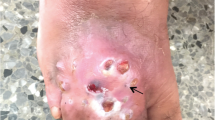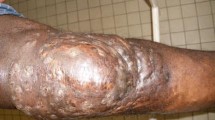Abstract
Mycetoma is a chronic granulomatous infectious disease that can affect the skin, subcutaneous tissue, fascia and bone. It can be caused by filamentous bacteria or fungi and usually involves the legs and feet. Mycetoma is endemic in tropical and subtropical regions and is easily misdiagnosed in clinical practice because of its nonspecific clinical features and lack of awareness of the disease. Although mycetoma is very rare in mainland China, an increasing number of cases have been reported in recent years. Here, we report a case of mycetoma in a patient who was misdiagnosed many years before receiving the correct treatment, leading to disease progression and motion limitation. The grains that represent microorganismal colonies were important clues for diagnosis. We also reviewed reported cases of mycetoma in mainland China. The majority of cases were reported from southern regions. Actinomycetoma was more commonly reported than was eumycetoma. The causative agents of actinomycetoma included Nocardia brasiliensis, N. asteroides, N. otitidiscaviarum, N. ninae and Gordonia terrae, and the causative fungi of eumycetoma were identified as Madurella mycetomatis, Fonsecaea pedrosoi and Acremonium falciforme. Notably, the diagnosis of mycetoma was delayed from months to decades in all of the patients, likely due to a lack of clinical experience. Our literature review suggests the importance of increased awareness of mycetoma in clinical practice, especially in non-endemic regions. Further investigative studies are needed to determine the real incidence of the disease in China.


Similar content being viewed by others
References
Zijlstra EE, van de Sande WWJ, Welsh O, Mahgoub ES, Goodfellow M, Fahal AH. Mycetoma: a unique neglected tropical disease. Lancet Infect Dis. 2016;16(1):100–12.
Yan J, Deng J, Zhou CJ, Zhong BY, Hao F. Phenotypic and molecular characterization of Madurella pseudomycetomatis sp. nov., a novel opportunistic fungus possibly causing black-grain mycetoma. J Clin Microbiol. 2010;48(1):251–7.
Wang X, Zhou T, Deng D, Guo Y. A case of cutaneous nocardiosis with involvement of the trachea, anterior mediastinum and sternum. Case Rep Dermatol. 2010;2(3):177–82.
Xia X, Hong S, Ai-E X. Eumycetoma due to Acremonium falciforme acquired in China. Mycoses. 2012;55(2):e4–7.
Wang S, Yang Q, Ye H, Si Z, Zhao H, Qiao J. Image Gallery: actinomycetoma caused by Gordonia terrae in an immunocompetent woman. Br J Dermatol. 2018;179(2):e90.
Schibli A, Goldenberger D, Krieg A, Hirschmann A, Bruder E, Osthoff M. Painless swelling of the forefoot and recurrent subcutaneous abscesses of the lower leg-two distinct presentations illustrating the spectrum of eumycetoma in a nonendemic country. PLoS Negl Trop Dis. 2017;11(4):e0005360.
Van de Sande WW. Global burden of human mycetoma: a systematic review and meta-analysis. PLoS Negl Trop Dis. 2013;7(11):e2550.
Fahal A, el Mahgoub S, El Hassan AM, Abdel-Rahman ME. Mycetoma in the Sudan: an update from the Mycetoma Research Centre, University of Khartoum, Sudan. PLoS Negl Trop Dis. 2015;9(3):e0003679.
Zarei Mahmoudabadi A, Zarrin M. Mycetoma in Iran: a review article. Mycopathologia. 2008;165(3):135–41.
Rattanavong S, Vongthongchit S, Bounphamala K, Vongphakdy P, Gubler J, Mayxay M, Phetsouvanh R, Elliott I, Logan J, Hill R, Newton PN, Dance D. Actinomycetoma in SE Asia: the first case from Laos and a review of the literature. BMC Infect Dis. 2012;12:349.
Nenoff P, van de Sande WW, Fahal AH, Reinel D, Schöfer H. Eumycetoma and actinomycetoma–an update on causative agents, epidemiology, pathogenesis, diagnostics and therapy. J Eur Acad Dermatol Venereol. 2015;29(10):1873–83.
Relhan V, Mahajan K, Agarwal P, Garg VK. Mycetoma: an update. Indian J Dermatol. 2017;62(4):332–40.
Iwasawa MT, Togawa Y, Kamada N, Kambe N, Matsue H, Yazawa K, Yaguchi T, Mikami Y. Lymphocutaneous type of nocardiosis caused by Nocardia vinacea in a patient with polymyositis. Mycopathologia. 2011;172(1):47–53.
Sampaio FM, Wanke B, Freitas DF, Coelho JM, Galhardo MC, Lyra, Lourenço MC, Paes RA, do Valle AC. Review of 21 cases of mycetoma from 1991 to 2014 in Rio de Janeiro, Brazil. PLoS Negl Trop Dis. 2017;11(2):e0005301.
Zein HA, Fahal AH, el Mahgoub S, El Hassan TA, Abdel-Rahman ME. Predictors of cure, amputation and follow-up dropout among patients with mycetoma seen at the Mycetoma Research Centre, University of Khartoum, Sudan. Trans R Soc Trop Med Hyg. 2012;106(11):639–44.
Qian J, Shen Y, Yu A, Sun J, Lv G. A case of mycetoma caused by Nocardial brasiliensis. J Clin Dermatol. 2002;31(5):312–3 (Article in Chinese).
Liang J, Yang H, Liu Z, Wu Y, Lin T, Fan J. Mycetoma caused by Nocardia asteroides. J Clin Dermatol. 2006;35(10):650–1 (Article in Chinese).
Chen X, Liu L, Zhang W. A case of mycetoma caused by Nocardia Asteroides. Chin J Derm Venereol. 2009;23(8):509–10 (Article in Chinese).
Chen B, Zhu L, Xuan X, Wu L, Zhou T, Zhang X, et al. Isolation of both Pseudozyma aphidis and Nocardia otitidiscaviarum from a mycetoma on the leg. Int J Dermatol. 2011;50(6):714–9.
Ma Y, Wu S, Huang H, Yang Y, Chen L. Differential diagnosis and treatment of cutaneous granuloma caused by actinomyces and Nocardia. J Microbes Infect. 2015;10(2):92–7 (Article in Chinese).
Zhang M, Zheng W, Li Y, Chen K, Yang X, Wang A, Liu Q. A case of mycetoma. Chin J Derm Venereol. 2018;32(5):562–4 (Article in Chinese).
Author information
Authors and Affiliations
Corresponding author
Ethics declarations
Conflict of interest
The authors declare that they have no conflict of interest.
Informed Consent
Informed consent was obtained from the patient for the publication of clinical figures and information.
Additional information
Publisher's Note
Springer Nature remains neutral with regard to jurisdictional claims in published maps and institutional affiliations.
Handling Editor: Yuping Ran.
Electronic Supplementary Material
Below is the link to the electronic supplementary material.
Rights and permissions
About this article
Cite this article
Wang, R., Yao, X. & Li, R. Mycetoma in China: A Case Report and Review of the Literature. Mycopathologia 184, 327–334 (2019). https://doi.org/10.1007/s11046-019-00324-z
Received:
Accepted:
Published:
Issue Date:
DOI: https://doi.org/10.1007/s11046-019-00324-z




